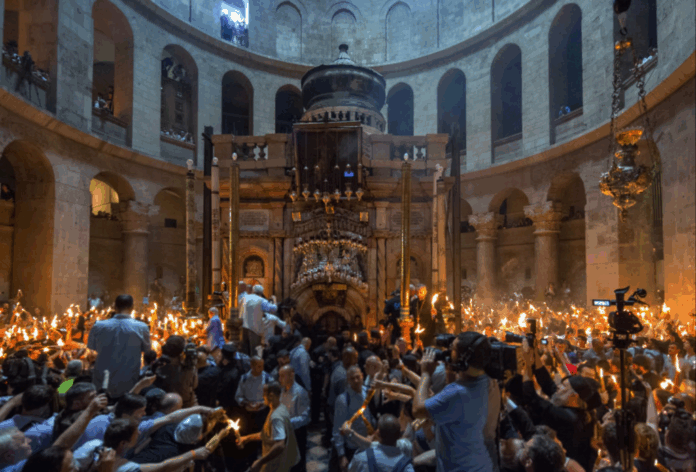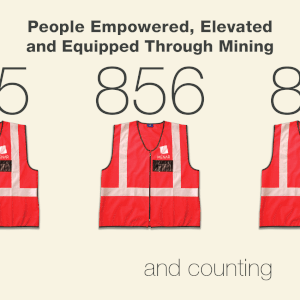By Mirna Fahmy
Inside the darkened dome of the Church of the Holy Sepulchre in Jerusalem, thousands wait in breathless silence. It is Holy Saturday. Pilgrims press shoulder to shoulder, some weeping, some praying, others holding bundles of unlit candles close to their hearts. At the very heart of Christianity’s most sacred site—the tomb believed to hold the body of Christ—the Greek Orthodox Patriarch disappears behind the stone doors.
Then, without matches, without spark, a flame bursts forth from the tomb. A roar rises from the crowd as the Patriarch emerges, holding aloft the Holy Fire. The flame spreads like a wave—first to the Armenian bishop, then to the Copts, then to the crowds, who shout “Christ is risen!” as candles flare to life. The ancient church glows from within. It is a miracle, say the faithful. It is tradition, say the skeptics. But for all who are present, it is a moment that transcends time.
And this year, the fire means more.
For the first time in years—and for only the eighth time this century—all Christians celebrate Easter together. Catholics, Protestants, Eastern and Oriental Orthodox churches mark the Resurrection on the same Sunday: April 20, 2025. From Jerusalem to Moscow, from Lagos to Lima, churches echo the same liturgies. In an era of political division and spiritual disconnection, this alignment feels almost cosmic.
Why Do Easter Dates Differ?
Unlike Christmas, which arrives each year on December 25 and January 7 with calendar certainty, Easter floats—sometimes as early as March, other times deep into April or even early May. The reason lies in a centuries-old intersection of astronomy, theology, and ecclesiastical divergence, which continues to shape how different Christian traditions experience their holiest day.
Typically, the difference in Easter celebrations between Catholics and Orthodox ranges from one week to as much as five weeks like last year (2024), depending on how the full moon and spring equinox fall according to each church’s calendar whereas Orthodox Easter is always celebrated later than the Catholic.
The Council of Nicaea in 325 AD established Easter’s general formula: it should be celebrated on the first Sunday after the first full moon following the spring equinox. This rule ties Easter not only to nature but also to Judaism, specifically the festival of Passover—the period during which, according to the Gospels, Jesus was crucified and resurrected.
That connection is not incidental.
According to the Gospels, Jesus celebrated the Passover meal (sedar)—the Last Supper—on Maundy Thursday night, was crucified on Friday, and resurrected by Sunday morning. This timeline places Easter after Passover, making the Jewish festival not just a narrative detail, but an essential part of the theological sequence.
Passover, or Pesach, is a central Jewish holiday that commemorates the Exodus—the liberation of the Israelites from slavery in Egypt after 430 years. Lasting seven or eight days depending on tradition, it is marked by the eating of matzah, an unleavened bread symbolizing the haste of departure, as there was no time to let the dough rise.
As theologian Brant Pitre writes, “The Last Supper was a Jewish Passover. That means that the entire mystery of the Eucharist, of Christ’s death and resurrection, is inseparable from the mystery of the Passover.”
This is precisely why the Eastern Orthodox Church insists that Easter must always fall after the Jewish Passover sticking to the Julian Calendar. For the Orthodox, maintaining that sequence is a matter of biblical fidelity, not just liturgical preference.
Following Niceas’s council, the Church of Alexandria was entrusted with calculating the date of Easter each year—a task rooted in its scholarly reputation in astronomy and calendar science. The responsibility fell to Pope Alexander I, one of the attending bishops at the Council of Nicaea, and later to Pope Athanasius, whose successors continued the tradition. Each year, they announced the Easter date through formal Festal Letters, which were sent to churches across the Christian world to ensure a unified observance.
Despite the theological split between the Church of Rome and the Church of Alexandria following the Council of Chalcedon in 451 AD—rooted in disputes over Christ’s divine and human natures—all Christian churches continued to observe Easter based on the same general formula established by the Council of Nicaea in 325 AD. However, a major shift occurred in 1582, when Pope Gregory XIII introduced the Gregorian calendar to correct the Julian calendar’s misalignment with the solar year. This reform was made without reference to the timing of the Jewish Passover, occasionally placing Easter before or during Passover—a move that disrupted the historical timeline of the Passion narrative.
This also has shifted the celebration of Christmas. Before the calendar change, all Christians marked the Nativity on what was December 25 in the Julian calendar, but today that same date corresponds to January 7 in the Julian system, which is why many Eastern churches continue to celebrate Christmas on that later date.
Since then, the Western Church—including Roman Catholics and most Protestant denominations—has used this updated astronomical formula, while Eastern churches retained the Julian calendar. This divergence remains the primary reason for the difference in Easter dates today.
The Western position stems partly from the desire of early Church leaders to distinguish Christianity from Judaism—not necessarily to erase its roots, but to establish an autonomous calendar. As early as the 4th century, prominent bishops like St. John Chrysostom voiced concerns about Christians celebrating “with the Jews,” prompting stricter separation.
Yet in 2025, the most awaited convergence occurs. Both calendars align their full moon and equinox calculations, and Easter falls on the same day: Sunday, April 20. The last time this happened was in 2017. In the 21st century from 2000 till 2025, both the Western and Eastern aligned nearly 8 times. The next few joint Easters will occur in 2028, 2031, and 2034, but such alignment remains infrequent—and unpredictable beyond a few decades.
Recent Efforts Toward Christian Unity
The dream of celebrating Easter on the same day across all Christian denominations has long been cherished by ecumenical leaders. In recent years, the idea has gained renewed momentum—particularly with the alignment of calendars in 2025, when Easter falls on April 20 for all major Christian traditions.
Pope Francis has been a consistent advocate for this cause. As part of his broader vision for Christian unity, he has held discussions with leaders such as Ecumenical Patriarch Bartholomew and Pope Tawadros II of the Coptic Orthodox Church in Egypt to explore the possibility of a fixed, shared date. Speaking in the context of the rare alignment in 2025, Pope Francis expressed hope that this could become a stepping stone toward a permanent unification of Easter observances. As reported by the Catholic News Agency (CNA), the Pope sees this convergence not just as symbolic, but as a meaningful opportunity for healing centuries of division.
Pope Tawadros II has been among the most vocal proponents of a unified Easter. Since 2014, he has called for Easter to be celebrated annually on the third Sunday of April conducting a comprehensive study on the feasibility of this proposal. The study was distributed to churches worldwide.
According to the findings, early church leaders intentionally avoided aligning Easter with Jewish Passover, fearing that such synchronization might expose Christianity to accusations of Judaisation. But the report concluded that in today’s context, such concerns no longer pose a theological risk:
“Currently, there is no threat of fixing a date for Easter celebrations because Christianity has firmly established itself, and early Judaisation concerns no longer pose a risk to the Christian faith,” the study stated.
During a 2018 pastoral visit, Pope Tawadros reiterated the Coptic Church’s proposal:
“We proposed that the unified date be set for the third Sunday of April, while some churches suggest it should be on the second Sunday. We are awaiting the consensus of all churches.”
This year’s unity has also inspired grassroots momentum. The Pasqua Together 2025 initiative, launched by several Christian lay movements—most notably the Focolare Movement—seeks to seize this rare alignment as a symbolic and practical precedent for the future. The initiative has received support from interfaith and ecumenical organizations, with key figures such as Kostas Mygdalis, a Greek national and advisor to the Orthodox Interparliamentary Assembly (IOA), playing an important role.
The timing is no accident: 2025 marks the 1,700th anniversary of the First Council of Nicaea, the same council that laid the groundwork for Easter’s date formula. As churches commemorate that historic moment, the hope is that Pasqua Together might be more than a coincidence—it might be the beginning of a new tradition.
The Days That Changed the World: The Meaning of Holy Week
If Easter is the culmination, then Holy Week is the unfolding drama. It is a sacred narrative lived year after year—a journey of betrayal, sacrifice, silence, and astonishing hope. For Christians, these days are not just historical re-enactments; they are spiritual participation in a divine mystery.
Before Easter arrives, Christians prepare through Lent—a season of fasting, reflection, and repentance. While Western churches observe 40 days, symbolizing Christ’s time in the wilderness, the Eastern Orthodox tradition extends the period to 55 days, incorporating additional preparatory weeks leading into the stricter Lenten fast.
The Holy week (aka Pain Week) begins with Palm Sunday, a day of paradox. Across churches, children wave palm branches or olive sprigs in imitation of the crowds that welcomed Jesus into Jerusalem as a king chanting “Hosanna to the Son of David.”
Holy Monday to Wednesday are often quieter, days of reflection and minor liturgies with day and night prayers at the churches known as Pascha.
Maundy Thursday, or Covenant Thursday, marks the Last Supper. In the Western churches, the foot-washing ritual recalls Jesus’ humility—the God who kneels to serve. In Eastern churches, long and solemn liturgies recount both the institution of the Eucharist and the beginning of Christ’s Passion. It is also the night of betrayal. Judas has taken his silver. The garden awaits.
Then comes the Good Friday, The crucifixion day. In Rome, the Pope leads a somber Via Crucis at the Colosseum. In Orthodox churches, the icon of Christ’s entombed body is surrounded with lilies, incense, and candlelight. In Jerusalem, the Via Dolorosa—the traditional path of Christ to the cross—fills with pilgrims carrying wooden crosses on their shoulders, re-tracing the last steps of Jesus.
It is a pilgrimage of the soul, but also of the body. Each year, Holy Week in Jerusalem draws tens of thousands of faithful from around the world. According to the Israeli Central Bureau of Statistics, over 150,000 Christian pilgrims visited in the weeks leading up to Easter in previous years—marking it as one of the holiest, and busiest, seasons of the Christian calendar.
During the COVID-19 pandemic, this moment passed in near silence. In 2020 and 2021, only a handful of priests were allowed inside the Church of the Holy Sepulchre. And now, in 2025, the ongoing war in Gaza casts another shadow. While Christian pilgrims have begun returning to Jerusalem—reaching numbers approaching pre-pandemic levels—travel has been marred by fear, visa restrictions, and a sense of moral tension.
On Holy Saturday, as the Church sits in silence, waiting by the sealed tomb, the miracle of the Holy Fire (aka Holy Light) breaks through the darkness. In the Church of the Holy Sepulchre, under its domes of incense and age, thousands gather with unlit candles. The anticipation is not merely ceremonial—it is electric. A divine flame descends spontaneously from within Christ’s tomb.
The Greek Orthodox Patriarch—Theophilos III—enters the tomb alone. But not before enduring a ritual of its own significance. Israeli police surround him as he approaches the Aedicule—the small shrine covering the tomb—escorting him tightly through the crowd. In a centuries-old custom meant to prove there is no human ignition of the fire, the Patriarch is searched, and he removes his liturgical robes, entering the tomb in simple white, with no matches, no lighters, no technology. The scene is both solemn and surreal: the spiritual leader of one of Christianity’s holiest sites stripped to his under-clothing under armed escort in order to access the miracle.
When he re-emerges, carrying the flame in two large bundles of candles, the unburnable Holy Fire spreads within seconds—first to clergy, then to pilgrims, until the church is ablaze with flickering light. This always happens around 1:00-1:30 pm Jerusalem time and during the time the Orthodox churches around the world usually celebrate at. Cries of joy, tears, and spontaneous chants fill the cavernous space.
What few visitors realize is that the key to the Church of the Holy Sepulchre itself is not held by any Christian denomination. In a testament to the fragile cooperation between rival Christian sects who share the space, and to centuries of Ottoman-era diplomacy, the key is entrusted to a Muslim family—the Joudeh al-Husseini family—who have safeguarded it since the 12th century. Every Holy Saturday, the door is opened by their hand.
And then—finally—Easter Sunday. Whether it is greeted by chants at dawn, cathedral choirs, or the pealing of ancient bells, the declaration is the same: “He is risen!” At that moment, Holy Week is fulfilled. Grief gives way to joy, silence to song.


